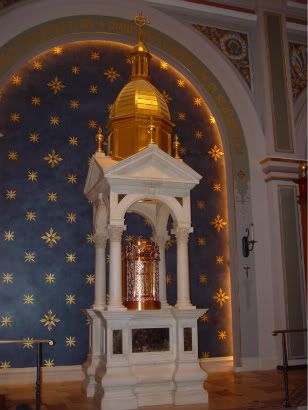 This article by Diana Macalintal first appeared in The Valley Catholic, March 2009 issue.
This article by Diana Macalintal first appeared in The Valley Catholic, March 2009 issue.Six years ago, Bishop Patrick J. McGrath, asked our diocese to examine its Communion practices at Mass. He asked parishes to ensure that:
- Communion from the cup be made available to all the faithful at every Sunday and feast day Mass;
- hosts from the tabernacle are not used at Mass—that is, except in cases of dire need, the Eucharistic bread that is shared by the faithful will be the same Eucharistic bread that is consecrated at that Mass; and
- the assembly take a unified posture during the Eucharistic Prayer as well as remain standing and singing during the Communion procession.
Over the years, there has been significant improvement throughout the diocese in these norms, which have been directives of the Church since 1969. Because of the good work of ordained and lay ministers charged with preparing the Mass and the efforts of the faithful, almost all of our parishes now offer the Precious Blood at all Sunday and feast day Masses and a majority of assemblies remain standing throughout Communion. This has resulted in a deepened understanding of the sacrificial and communal aspects of Communion.
Over the next year, we will examine these norms and other elements of the Mass. We begin with the second norm—avoiding distributing hosts from the tabernacle at Mass.
What’s the difference?
Now, aren’t the hosts in the tabernacle the same Body of Christ as those received from the altar? Yes. Consecrated hosts not consumed at Mass are reserved in the tabernacle.
So why make a fuss? Because the difference is not in the consecrated elements but in the action that happens before we share those elements.
The Mass is made up of the Liturgy of the Word, in which we hear the Scriptures and respond to them through the homily and intercessions, and the Liturgy of the Eucharist. This second section is not simply when we share Communion. First, we must bring to the altar the bread and wine to be consecrated and our offering for the poor. In this simple presentation of gifts, we see one way the Eucharist is a sacrifice. We imitate Jesus, who gave his very life for others, by giving ourselves through the sacrifice of the earth and the work of our hands, that formed wheat into bread, grape into wine, and labor into care for those in need.
Sacrifice of praise
Next we unite with the priest who speaks the Eucharistic Prayer in the name of the community. The General Instruction of the Roman Missal (GIRM), the document that directs the Mass, says that the “meaning of the Prayer is that the entire congregation of the faithful should join itself with Christ in confessing the great deeds of God and in the offering of Sacrifice” (78).
The culmination of Christ’s sacrifice of praise is our sharing in his Body and Blood. Thus, in the same way that Christ’s sacrifice of his very body is preceded by a life lived as an offering of praise to the Father, so too do we precede Communion with the sacrifice of our lives and our offering of praise to God. Through the Eucharistic Prayer, the bread and wine we place on the altar is intimately connected to the Body and Blood of Christ we receive from that same altar. This is why GIRM, 85, says, “[i]t is most desirable that the faithful, just as the priest himself is bound to do, receive the Lord's Body from hosts consecrated at the same Mass…so that even by means of the signs Communion will stand out more clearly as a participation in the sacrifice actually being celebrated.”
When we distribute hosts from the tabernacle at Mass, we devalue our participation in Christ’s sacrifice of praise to the Father and sever the sacrificial connection between the offering of our lives and Christ’s salvific offering of his. This connection is the heart of the Eucharist; it is what distinguishes Mass from a Communion service. This is why our Bishop has asked that hosts from the tabernacle should be used only for Communion to the sick outside of Mass and for the distribution of Holy Communion outside of Mass.
No comments:
Post a Comment